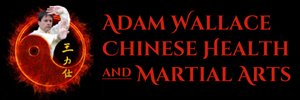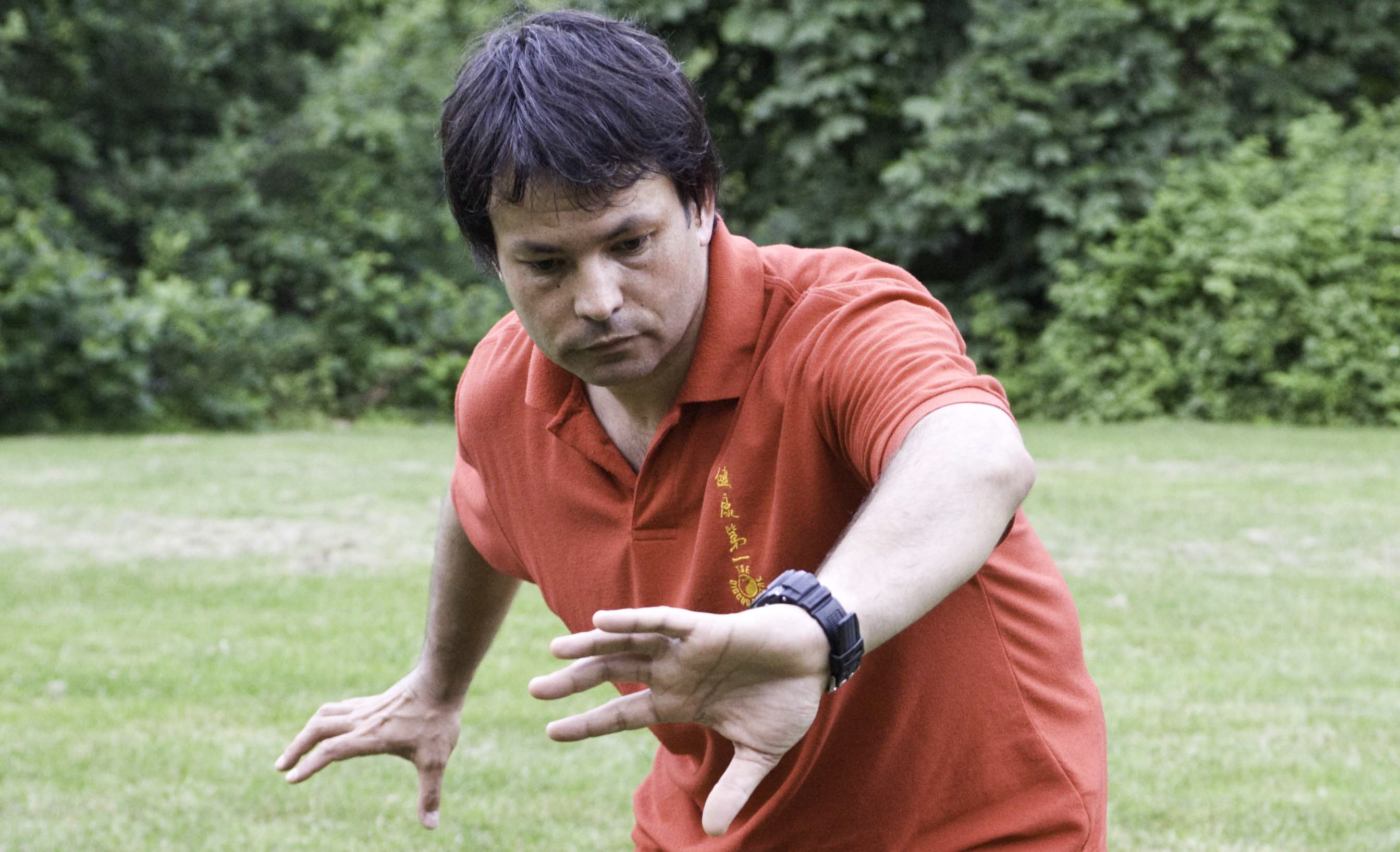A doctor of Traditional Chinese Medicine utilizes many methods to diagnose a patient, including observation of the tongue and eyes, checking pulses, listening to the voice etc. The appearance and energy of the hand, as well as touch, gives us much information, from the condition of a person’s health to the level of a practitioner’s skill.
A healthy palm tends to be pinkish, flecked red and white. Predominantly white palms mean poor blood circulation (the result of pathogenic ‘Cold’), and red or purplish hands indicate pathogenic ‘heat’ and blood stagnation. These conditions can easily be remedied by Qigong practice, or Chinese medicine and/or diet. One quick method to check circulation is to pinch the end of the fingers for about 10 seconds and see how quickly the color returns. One or two seconds color restoration is good, while five or longer is not so good.
The skin covering the hands should be soft, elastic, and smooth. Skin relates to the lungs, so dry or cracked hands indicates internal Dryness. This can be corrected by tonifying the lungs. When the skin is red and blotchy, including acne, there is excess Heat and the Heart and Liver Qi need to be regulated. The fingernails reflect the condition of the Liver. The dryness or moisture of the nails depends on sufficiency or insufficiency of Liver blood. When Liver blood is abundant, the nails appear hard and moist. When Liver blood is insufficient and incapable of adequately nourishing the tendons, then the nails can be thin, soft, brittle, and pale.
Qi is like the sap of a tree. When the sap is full, then the trunk and limbs swell, and become fuller and stronger. When Qi is abundant the marrow is fed and bones become stronger and the flesh around the fingers will be fuller. This should not be confused with swollen hands, which indicates stagnation of Qi and blood. Thin, bony hands with very little flesh covering means Yin Excess (Yang Deficiency), and manifest in being overly sensitive to cold as Qi and Blood is deficient. Women lose Qi through the blood loss during menstruation, and men lose Qi through semen ejaculation. If the constitution is weak, and loss of this Qi is excessive, then the drop in vitality is more quantifiable. Qi retreats from the extremities to nourish or protect the internal organs, like during hypothermia. When this happens the flesh around the fingers becomes thinner, the skin becomes wrinkled (like after a long bath), the color becomes paler, and the hands will feel colder. Due to this internal imbalance, and depleted Qi, people feel more vulnerable and sensitive, and become emotionally unstable during this time. When we finish our practice, the hands should feel warmer, and fuller, with more color.
Mind is the ultimate controller of Qi, but the hands are instrumental conduits for guiding and directing Qi. Qi can be guided by Mind alone, since “Qi Flows where Mind/ (Intention) Goes”, but some methods of Qigong emphasize using mind exclusively. This is not recommended! For some, it may be like a shortcut. But, this method is incomplete, in the sense that the joints, bones, muscles and tendons also need to trained, and if taught or practiced improperly, then a host of side-effects (the subject of a future ‘Lesson’) can result. With Qigong, when we begin our practice (as Relaxation) and end it (as Collecting Qi) this sinking of Qi can be accomplished without the arms and hands, but is more powerful using them and the feeling more quantifiable with dropping the weight of the arms, and the Laogong points on the palms more effective in smoothing the internal lines.
Wild Goose (Dayan) Qigong is an ancient Chinese health skill, and sanctioned by the Chinese government, as a ‘safe’ method, because of its lack of reported side effects. This is really due to the fact that the entire body is used to move Qi, and not Mind alone. It utilizes many different hand shapes to manipulate Qi. For example, flat hands are used to guide the flow of internal Qi, arched hands help absorb external Qi; hollow-fist hands are used to grasp or collect external Qi; claw-shaped hands concentrate Qi to the palm and bring it to various acupuncture points (such as Shenshu, Dabao and Dai Mai etc); the wrist-pressing hand shape pushes out the sick/ turbid/ stagnant Qi, and dredges the channels; vibrating hands release sick Qi, stimulate the internal organs, and calm the central nervous system; ‘Sword Fingers’ transmits the Qi in a straight line (like a laser beam); and ‘Tiger Mouth’ shape brings Qi to the Hegu points to connect with acu-points, such as Qi Hai and Mingmen, and channels such as Ren and Du. There are two acupuncture points within the hand that are important to transmitting and guiding Qi – Hegu (in the web where thumb and index finger meet) and Laogong (center of the palm). As we practice, these points need to be opened and closed, so Qi can pass in and out. And, when this is achieved, it is as if the hands themselves are breathing too, like kelp, anemone, or soft coral swaying in the deep ocean, flowing with the currents.
All styles of Chinese martial art contain their own unique energy and attitude, or ‘flavor’ that differentiates them from one another. This energy is manifest in the posture and footwork, it is manifest in the eyes and expression, and it is manifest in the hands. With Chen Style Taijiquan, the basic open-handed palm shape requires the thumb and little finger to be drawn inwards, towards each other, and the fingers, in between like “the tiles on a roof”. The palm should be slightly rounded (as opposed to flat) and the wrist should be slightly relaxed (neither locked nor dropped). Many Taiji practitioners spread their fingers, or else pack their fingers together tightly. In both cases, though basically opposite extremes, the hand is rigid. Those that see the slow movements of Taijiquan can mistakenly assume the practitioner is relaxed, but slow can still be stiff, and in some cases, it is. The same open hand in Shaolin Kungfu or Wing Chun requires the palm a little flatter, fingers straight but relaxed, and the thumb tucked in, behind the first joint of the index finger. Unlike in Qigong, whereby the thumb and index finger part to open the Hegu point, in martial arts, the thumb must be kept in to protect it from being grabbed and twisted, or broken, by an opponent.
Some internal students/ practitioners fail to relax, which impedes the smooth flow of Qi, and is contrary to the goal. With just the one part of the body apparently stiff, like the wrists or fingers, the intrinsic energy of the entire body will be affected, and appear stiff. When the Qi flows unimpeded throughout the body, it will manifest in the hands. Good dancers feel the music through their entire bodies and express this energy through their limbs and extremities. Internal practitioners become aware of the internal body and Qi, and understand how to enable its free passage through their bodies. On the other hand, ‘internal’ practitioners easily mistake ‘relaxed’ for ‘collapsed’. In this situation, forms are practiced and performed as though comatose, with posture becoming slack and deformed, and hands becoming limp, devoid of energy, as the fingers curl inwards, like dried up fallen autumn leaves. In this case there is no sensation in the hands, as Mind and Qi does not reach the fingertips. Once we consciously open the hand, to the correct shape, then as Mind goes to the fingers so too does Qi and strength.
With regard to martial art partner training, competition or real life defense against an opponent, skills like Taijiquan and Wing Chun require sensitivity (or Ting Jing/ “Listening Skill’) to read the opponent’s intentions, to avoid force, lead the opponent to ‘Emptiness’, and attack the path of least resistance. We rely on our eyes to see the initial attack, and our reflexes to react, but once our arms and hands make contact with the opponent’s, any changes in attack can be felt, which is quicker and more trusted than the eyes, that may not see in time and can be tricked.
Contacting the opponent’s hands, and arms, gives us much information, including the opponent’s level of skill. It is a common maxim that that the softer and lighter the touch of a partner’s or opponent’s hands, the more dangerous he can be. Why is this? Stiff, tense hands betray trepidation, nervousness, insecurity, and fear of losing control (of the situation). It is a mistake or ignorance to assume that soft, or light, equals weak. A soft or light touch means relaxation, which means greater sensitivity, and shows the confidence of one that is unconcerned, cool and collected, and can adapt easily to rapidly changing conditions. This is why the high level practitioners seem mysterious or even psychic, able to read an opponent and react before he is even able to launch his attack. The one with the light touch and sensitivity becomes like a shadow or a ghost, breezing through the opponent’s defenses, like wind stealing through the cracks in a window or door, so that by the time the opponent realizes it is too late for him. Those with stiff or tense hands not only tend to react more sluggishly in defense, but in attack, their movement is more detectable, and predictable, to the person with greater sensitivity.
Through steady internal practice, as Qi and blood circulation become stronger the internal body changes – bones, muscles, tendons, and flesh become fuller. A good martial artist or Qigong exponent after many years of internal and external training should be brimming with Qi. He will not possess pale, thin bony, or weak hands. The condition of the internal body is manifest on the outside. The hands show and express Qi, they transmit and direct Qi, for healing (ourself and others) and are most important tools to sense an attacker’s energy and intentions and as weapons for self-defense.
– Adam Wallace

